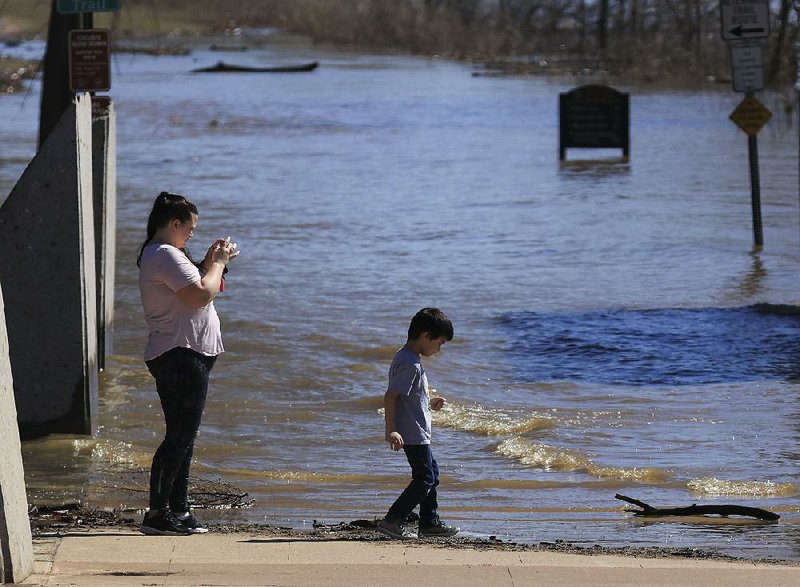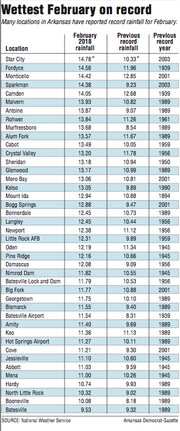Another 2 to 5 inches of rain is forecast for much of waterlogged Arkansas through Thursday night, according to the National Weather Service in North Little Rock.
Little Rock, Arkadelphia and Brinkley are in the bull's-eye, said Joe Goudsward, a meteorologist with the National Weather Service. Those cities -- and everything in between -- could see 5 inches of additional rain through Thursday.
The rain is expected to begin today, transition into thunderstorms tonight and Wednesday, then taper off late Thursday. A flood watch is in effect for much of the state from tonight through Thursday morning.
So far, Friday looks clear and sunny.
Click here for larger versions
Photos by The National Weather Service
Photos by The National Weather Service
It has already been the wettest February on record for 42 locations in Arkansas. Star City in Lincoln County has had the most rain this month with 14.78 inches, breaking the previous record of 10.33 inches in 2003, according to the National Weather Service.
It's followed by Fordyce in Dallas County with 14.56 inches, breaking the previous record of 11.96 inches set in 1939.
Mount Ida in Montgomery County broke a record set in 1894 with 12.94 inches of rain this month.
At Little Rock Air Force Base in Jacksonville, rain totaled 12.31 inches this month, beating the former record of 9.89 inches in 1959.
Some parts of Arkansas received more than 10.5 inches of rain between Feb. 20-25, according to the University of Arkansas System Division of Agriculture.
Meteorologist Hayden Nix with KARK-TV in Little Rock calculated 6.7 trillion gallons of rain fell on Arkansas last week. That's based on an average of 7.22 inches of rain at 20 different locations around the state.
The rain has exacerbated the pox of potholes in Little Rock. Ten teams worked Monday to repair potholes, which have been made worse by heavy rains, city Public Works Department Director Jon Honeywell said in a news release. They'll continue working on potholes through the rest of the week. Little Rock residents can report the potholes by dialing 311.
Dan Koch, another meteorologist with the National Weather Service, said heavy rain -- totaling 2 inches or more -- is in the forecast for a large swath of the state southeast of a line running from Glenwood to Conway to Searcy.
Rainfall will be lighter in Northwest Arkansas, with Fayetteville expecting one-half to 1 inch of rain through Thursday.
The additional rain could cause flooding in particular along the White River from Des Arc to Clarendon, Koch said.
The Ouachita River at Camden and the Saline River at Rye, north of Warren, have been flooding already, but most of the water has gone into cropland and timber, Koch said.
"We've got some pretty significant flooding in a few spots," Koch said Monday. "The Cache River always floods. It's a real slow-draining system that's east of the White River. It takes a very long time for the water to get out of there. Just about now we're up to major flood stage.
"The duck hunters love this kind of thing in the spring, but right now it's just going to flood a bunch of farmland."
That floodwater can damage farm fences and county roads, according to a news release from the UA System Division of Agriculture.
Many farmers moved cattle to higher ground before the flood and provided them with hay, according to the release.
Extension Staff Chairman Kevin Lawson said most of the damage he saw was to fences.
"We were fortunate the Arkansas and Fourche La Fave rivers were so low," he said in the release.
Koch said the White River is expected to crest at 23 feet at Georgetown in White County on Thursday, which is flood stage. In previous years, when the river level rose to 26 feet, it forced the closure of Arkansas 36, the only highway into town, he said.
"In past years, it has cut the town off and the only way to get in there is by boat," Koch said.
Michael Lincoln, the county judge in White County, said he hadn't heard predictions of the water getting that high at Georgetown this time.
"They're very prepared for it," he said of Georgetown residents. "All of them have boats. Their main concern is not leaving for people taking advantage of their property. So they're hunkered down."
Lincoln said White County was drying out a little with every hour of sunshine Monday.
On Monday, the National Weather Service didn't have a solid forecast beyond Thursday, but the extended forecast called for a 30 percent chance of rain at Georgetown on Sunday and a 50 percent chance next Monday.
The White River is expected to be at 32.7 feet at Clarendon on Thursday, Koch said. That could flood Arkansas 302 and some industrial property in town, he said. The Cache River flows into the White River just north of Clarendon.
Koch said there has been some flooding at Osceola on the Mississippi River, but it has been contained within the levee system. He said the Mississippi River is expected to crest at 37 feet at Osceola on Monday or Tuesday.
Three county judges have filed disaster emergency proclamations, and seven others have verbally declared an emergency.
The written requests came from Chicot, Clay and White counties, said Dan Noble, a spokesman for the Arkansas Department of Emergency Management. Verbal requests came from Cleveland, Clark, Faulkner, Lee, Logan, Mississippi and Randolph counties.
Those 10 counties have yet to request assistance from the state, said A.J. Gary, Arkansas' emergency management director.
"There's small damage in a bunch of different counties," Gary said. "Those counties have got the resources, so they are handling it very well. Because this is a flood event, they may not see all the damage."
Although the focus is on the flood event, two EF-1 tornadoes hit Clay and Mississippi counties Saturday night, causing some wind damage and contributing to the death of 83-year-old Albert Charles Foster, who died after his trailer home in Clay County was blown into a pond.
Metro on 02/27/2018

